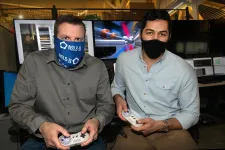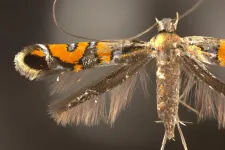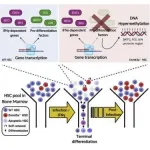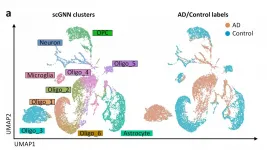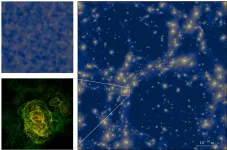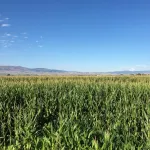(Press-News.org) UPTON, NY — Inspired by the mastery of artificial intelligence (AI) over games like Go and Super Mario, scientists at the National Synchrotron Light Source II (NSLS-II) trained an AI agent – an autonomous computational program that observes and acts – how to conduct research experiments at superhuman levels by using the same approach. The Brookhaven team published their findings in the journal Machine Learning: Science and Technology and implemented the AI agent as part of the research capabilities at NSLS-II.
As a U.S. Department of Energy (DOE) Office of Science User Facility located at DOE’s Brookhaven National Laboratory, NSLS-II enables scientific studies by more than 2000 researchers each year, offering access to the facility’s ultrabright x-rays. Scientists from all over the world come to the facility to advance their research in areas such as batteries, microelectronics, and drug development. However, time at NSLS-II’s experimental stations – called beamlines – is hard to get because nearly three times as many researchers would like to use them as any one station can handle in a day—despite the facility’s 24/7 operations.
“Since time at our facility is a precious resource, it is our responsibility to be good stewards of that; this means we need to find ways to use this resource more efficiently so that we can enable more science,” said Daniel Olds, beamline scientist at NSLS-II and corresponding author of the study. “One bottleneck is us, the humans who are measuring the samples. We come up with an initial strategy, but adjust it on the fly during the measurement to ensure everything is running smoothly. But we can’t watch the measurement all the time because we also need to eat, sleep and do more than just run the experiment.”
“This is why we taught an AI agent to conduct scientific experiments as if they were video games. This allows a robot to run the experiment, while we – humans – are not there. It enables round-the-clock, fully remote, hands-off experimentation with roughly twice the efficiency that humans can achieve,” added Phillip Maffettone, research associate at NSLS-II and first author on the study.
According to the researchers, they didn’t even have to give the AI agent the rules of the ‘game’ to run the experiment. Instead, the team used a method called “reinforcement learning” to train an AI agent on how to run a successful scientific experiment, and then tested their agent on simulated research data from the Pair Distribution Function (PDF) beamline at NSLS-II.
Beamline Experiments: A Boss Level Challenge
Reinforcement learning is one strategy of training an AI agent to master an ability. The idea of reinforcement learning is that the AI agent perceives an environment – a world – and can influence it by performing actions. Depending on how the AI agent interacts with the world, it may receive a reward or a penalty, reflecting if this specific interaction is a good choice or a poor one. The trick is that the AI agent retains the memory of its interactions with the world, so that it can learn from the experience for when it tries again. In this way, the AI agent figures out how to master a task by collecting the most rewards.
“Reinforcement learning really lends itself to teaching AI agents how to play video games. It is most successful with games that have a simple concept—like collecting as many coins as possible—but also have hidden layers, like secret tunnels containing more coins. Beamline experiments follow a similar idea: the basic concept is simple, but there are hidden secrets we want to uncover. Basically, for an AI agent to run our beamline, we needed to turn our beamline into a video game,” said Olds.
Maffettone added, “The comparison to a video game works well for the beamline. In both cases, the AI agent acts in a world with clear rules. In the world of Super Mario, the AI agent can choose to move Mario up, down, left, right; while at the beamline, the actions would be the motions of the sample or the detector and deciding when to take data. The real challenge is to simulate the environment correctly – a video game like Super Mario is already a simulated world and you can just let the AI agent play it a million times to learn it. So, for us, the question was how can we simulate a beamline in such a way that the AI agent can play a million experiments without actually running them” said Maffettone.
The team “gamified” the beamline by building a virtual version of it that simulated the measurements the real beamline can do. They used millions of data sets that the AI agent could gather while “playing” to run experiments on the virtual beamline.
“Training these AIs is very different than most of the programming we do at beamlines. You aren’t telling the agents explicitly what to do, but you are trying to figure out a reward structure that gets them to behave the way you want. It’s a bit like teaching a kid how to play video games for the first time. You don’t want to tell them every move they should make, you want them to begin inferring the strategies themselves.” Olds said.
Once the beamline was simulated and the AI agent learned how to conduct research experiments using the virtual beamline, it was time to test the AI’s capability of dealing with many unknown samples.
“The most common experiments at our beamline involve everything from one to hundreds of samples that are often variations of the same material or similar materials – but we don’t know enough about the samples to understand how we can measure them the best way. So, as humans, we would need to go through them all, one by one, take a snapshot measurement and then, based on that work, come up with a good strategy. Now, we just let the pre-trained AI agent work it out,” said Olds.
In their simulated research scenarios, the AI agent was able to measure unknown samples with up to twice the efficiency of humans under strongly constrained circumstances, such as limited measurement time.
“We didn’t have to program in a scientist’s logic of how to run an experiment, it figured these strategies out by itself through repetitive playing.” Olds said.
Materials Discovery: Loading New Game
With the AI agent ready for action, it was time for the team to figure out how it could run a real experiment by moving the actual components of the beamline. For this challenge, the scientists teamed up with NSLS-II’s Data Acquisition, Management, and Analysis Group to create the backend infrastructure. They developed a program called Bluesky-adaptive, which acts as a generic interface between AI tools and Bluesky – the software suite that runs all of NSLS-II's beamlines. This interface laid the necessary groundwork to use similar AI tools at any of the other 28 beamlines at NSLS-II.
“Our agent can now not only be used for one type of sample, or one type of measurement—it’s very adaptable. We are able to adjust it or extend it as needed. Now that the pipeline exists, it would take me 45 minutes talking to the person and 15 minutes at my keyboard to adjust the agent to their needs,” Maffettone said.
The team expects to run the first real experiments using the AI agent this spring and is actively collaborating with other beamlines at NSLS-II to make the tool accessible for other measurements.
“Using our instruments’ time more efficiently is like running an engine more efficiently – we are making more discoveries per year happen. We hope that our new tool will enable a new transformative approach to increase our output as user facility with the same resources.”
The team who made this advancement possible also consists of Joshua K. Lynch, Thomas A. Caswell and Stuart I. Campbell from the NSLS-II DAMA Group and Clara E. Cook from the University at Buffalo.
This study was supported by a BNL Laboratory Directed Research and Development (LDRD) fund and the U.S. Department of Energy’s (DOE) Office of Science (BES). The National Synchrotron Light Source II (NSLS-II) is a DOE Office of Science User Facility operated for the DOE Office of Science by Brookhaven National Laboratory.
Brookhaven National Laboratory is supported by the U.S. Department of Energy’s Office of Science. The Office of Science is the single largest supporter of basic research in the physical sciences in the United States and is working to address some of the most pressing challenges of our time. For more information, visit https://energy.gov/science.
Game on: Science edition
After AIs mastered Go and Super Mario, Brookhaven scientists have taught them how to "play" experiments at NSLS-II
2021-03-25
ELSE PRESS RELEASES FROM THIS DATE:
Study introduces 13 new, threatened species of sparkly moths from Hawaii
2021-03-25
Akito Kawahara was snapping pictures at a scenic outlook in Hawaii when he spotted the moth equivalent of a dodo.
An entomologist, Kawahara recognized the squiggly patterns on nearby plants as trails carved by leaf-mining caterpillars and lowered his camera to take a closer look. To his astonishment, he saw a tiny moth most experts assumed was extinct. It belonged to a genus known as Philodoria, a type of moth found only in Hawaii and one that hadn’t been documented in the wild since 1976.
“I thought, ‘Oh my God, there’s a Philodoria ...
Consumers will dub activist brands as 'woke-washers' if they cannot prove moral competency
2021-03-25
New research shows that consumers judge 'activist brands' based on how morally competent they are perceived to be when challenging free speech.
The report, co-authored by experts at the Business School (formerly Cass), Birkbeck, University of London and the University of Sussex Business School explains that stakeholders draw their conclusions on the biggest brands by measuring three moral skills: sensitivity, vision, and integration.
Lacking these traits, a brand raising controversy is judged as transgressing, reproducing and manipulating the boundaries of free speech. Displaying these traits proves the brand is not merely 'woke-washing' ...
Study reveals how long-term infection and inflammation impairs immune response as we age
2021-03-25
HOUSTON, TX - March 25, 2021 - Humans are born with tens of thousands of hematopoietic stem cells (HSCs) that collectively ensure lifelong production of blood and immune cells that protect us from infections. HSCs can either duplicate to produce more stem cell progeny or differentiate to produce distinct immune cell lineages, an extremely critical decision that ensures that the body achieves the fine balance between having enough immune cells to fight invaders while still retaining enough HSCs to maintain future blood production. As we age, HSCs accumulate mutations that lead to the ...
The case of the cloudy filters: Solving the mystery of the degrading sunlight detectors
2021-03-25
More than 150 years ago, the Sun blasted Earth with a massive cloud of hot charged particles. This plasma blob generated a magnetic storm on Earth that caused sparks to leap out of telegraph equipment and even started a few fires. Now called the Carrington Event, after one of the astronomers who observed it, a magnetic storm like this could happen again anytime, only now it would affect more than telegraphs: It could damage or cause outages in wireless phone networks, GPS systems, electrical grids powering life-saving medical equipment and more.
Sun-facing satellites monitor the Sun's ultraviolet (UV) light to give us advance warning of solar storms, both big ones that could cause a Carrington-like ...
Gene discovery confirms role of serine deficiency in rare eye disease
2021-03-25
NEW YORK, NY--Treatments for a rare retinal disease may be on the horizon after a new study has identified gene variants that cause a metabolic deficiency in the eye.
The disease, macular telangiectasia type 2 (MacTel), has been a research focus of Rando Allikmets, PhD, a pioneer in the genetics of eye diseases, for nearly 15 years. MacTel occurs in approximately 1 in 5,000 adults over age 40 and slowly causes a significant loss of central vision, which can impair driving, reading, and other activities.
"MacTel is clearly a genetic disease because it tends to run in families, but it's been a tough nut to crack," says Allikmets, the William and Donna Acquavella Professor of Ophthalmic Sciences ...
Moffitt researchers use mathematical modeling to analyze dynamics of CAR T-cell therapy
2021-03-25
TAMPA, Fla. -- Chimeric antigen receptor T-cell therapy, or CAR T, is a relatively new type of therapy approved to treat several types of aggressive B cell leukemias and lymphomas. Many patients have strong responses to CAR T; however, some have only a short response and develop disease progression quickly. Unfortunately, it is not completely understood why these patients have progression. In an article published in Proceedings of the Royal Society B, Moffitt Cancer Center researchers use mathematical modeling to help explain why CAR T cells work in some patients and not in others.
CAR T is a type of personalized immunotherapy that uses a patient's own T ...
New UCF nanotech gives boost to detection of cancer and disease
2021-03-25
ORLANDO, March 25, 2021 - Early screening can mean the difference between life and death in a cancer and disease diagnosis. That's why University of Central Florida researchers are working to develop a new screening technique that's more than 300 times as effective at detecting a biomarker for diseases like cancer than current methods.
The technique, which was detailed recently in the Journal of the American Chemical Society, uses nanoparticles with nickel-rich cores and platinum-rich shells to increase the sensitivity of an enzyme-linked immunosorbent assay (ELISA).
ELISA is a test ...
A new way to visualize mountains of biological data
2021-03-25
Studying genetic material on a cellular level, such as single-cell RNA-sequencing, can provide scientists with a detailed, high-resolution view of biological processes at work. This level of detail helps scientists determine the health of tissues and organs, and better understand the development of diseases such as Alzheimer's that impacts millions of people. However, a lot of data is also generated, and leads to the need for an efficient, easy-to-use way to analyze it.
Now, a team of engineers and scientists from the University of Missouri and the Ohio State University have created a new way to analyze data from single-cell RNA-sequencing ...
The very first structures in the Universe
2021-03-25
The very first moments of the Universe can be reconstructed mathematically even though they cannot be observed directly. Physicists from the Universities of Göttingen and Auckland (New Zealand) have greatly improved the ability of complex computer simulations to describe this early epoch. They discovered that a complex network of structures can form in the first trillionth of a second after the Big Bang. The behaviour of these objects mimics the distribution of galaxies in today's Universe. In contrast to today, however, these primordial structures are microscopically small. Typical clumps have masses of only a few grams and fit into volumes much smaller than present-day elementary particles. The results of the study have been published ...
Size of grass blades offers better understanding of their vulnerability to climate change
2021-03-25
One-third of the Earth's surface is covered by more than 11,000 grass species -- including crops like wheat, corn, rice and sugar cane that account for the bulk of the world's agricultural food production and important biofuels. But grass is so common that few people realize how diverse and important it really is.
Research published today in the journal Nature provides insights that scientists could use not only to improve crop design but also to more accurately model the effects of climate change. It also offers new clues that could help scientists use ...
LAST 30 PRESS RELEASES:
Heart-brain connection: international study reveals the role of the vagus nerve in keeping the heart young
Researchers identify Rb1 as a predictive biomarker for a new therapeutic strategy in some breast cancers
Survey reveals ethical gaps slowing AI adoption in pediatric surgery
Stimulant ADHD medications work differently than thought
AI overestimates how smart people are, according to HSE economists
HSE researchers create genome-wide map of quadruplexes
Scientists boost cell "powerhouses" to burn more calories
Automatic label checking: The missing step in making reliable medical AI
Low daily alcohol intake linked to 50% heightened mouth cancer risk in India
American Meteorological Society announces Rick Spinrad as 2026 President-Elect
Biomass-based carbon capture spotlighted in newly released global climate webinar recording
Illuminating invisible nano pollutants: advanced bioimaging tracks the full journey of emerging nanoscale contaminants in living systems
How does age affect recovery from spinal cord injury?
Novel AI tool offers prognosis for patients with head and neck cancer
Fathers’ microplastic exposure tied to their children’s metabolic problems
Research validates laboratory model for studying high-grade serous ovarian cancer
SIR 2026 delivers transformative breakthroughs in minimally invasive medicine to improve patient care
Stem Cell Reports most downloaded papers of 2025 highlight the breadth and impact of stem cell research
Oxford-led study estimates NHS spends around 3% of its primary and secondary care budget on the health impacts of heat and cold in England
A researcher’s long quest leads to a smart composite breakthrough
Urban wild bees act as “microbial sensors” of city health.
New study finds where you live affects recovery after a hip fracture
Forecasting the impact of fully automated vehicle adoption on US road traffic injuries
Alcohol-related hospitalizations from 2016 to 2022
Semaglutide and hospitalizations in patients with obesity and established cardiovascular disease
Researchers ‘listen in’ to embryo-mother interactions during implantation using a culture system replicating the womb lining
How changing your diet could help save the world
How to make AI truly scalable and reliable for real-time traffic assignment?
Beyond fragmented markets: A new framework for efficient and stable ride-pooling
Can shape priors make road perception more reliable for autonomous driving?
[Press-News.org] Game on: Science editionAfter AIs mastered Go and Super Mario, Brookhaven scientists have taught them how to "play" experiments at NSLS-II
